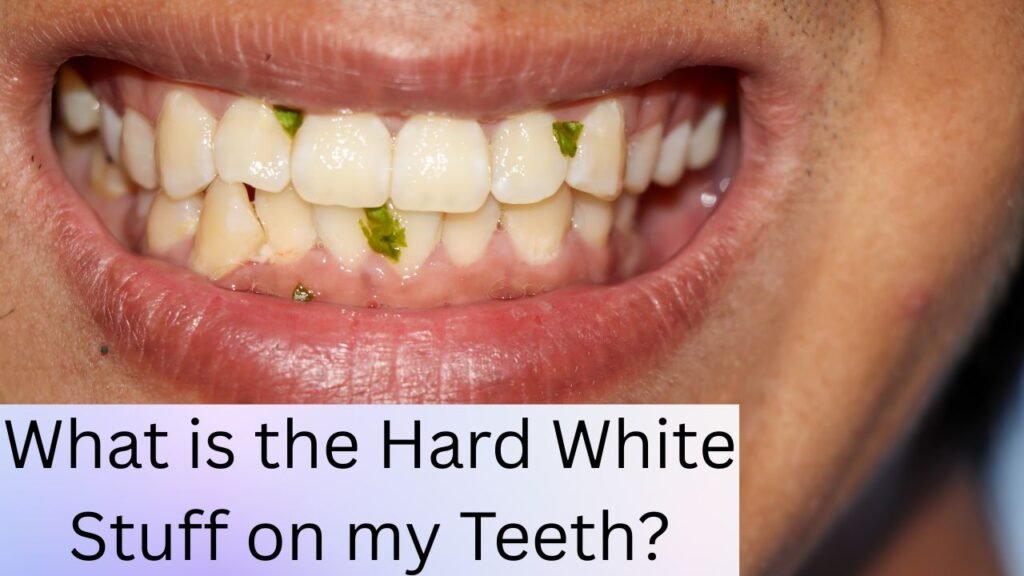What is the Hard White Stuff on my Teeth?
What’s That Hard White Stuff on My Teeth? Let’s Break It Down
Ever noticed a hard white substance stuck along your gumline, or maybe between your teeth?
Even after brushing, flossing, and rinsing, it just won’t budge?
👉 That, right there, is tartar – also called dental calculus.
It’s not just something cosmetic. It’s a sign that plaque, which is soft and sticky, has hardened over time, becoming a rock-like deposit on your teeth. And no, regular brushing won’t remove it. This guide will empower you to understand, deal with, and most importantly prevent this stubborn buildup – protecting both your smile and your overall oral health.

What Exactly Is Tartar (Dental Calculus)?
Tartar is calcified plaque. Let’s make it simple:
| Plaque | Tartar (Calculus) |
|---|---|
| Soft, sticky biofilm | Hard, crusty mineral buildup |
| Forms daily after eating/drinking | Forms when plaque isn’t removed |
| Can be cleaned at home | Needs a dental professional to remove |
| Colorless or pale yellow | Usually white, yellow, or even brown |
Here’s how it forms:
- You eat or drink (especially sugary stuff).
- Bacteria in your mouth create plaque.
- If that plaque isn’t removed within 48 to 72 hours, it starts to absorb calcium and phosphate from your saliva.
- These minerals, which come from both your food and your body’s natural processes, harden the plaque.
- Result? Tartar.
It can feel rough, chalky, or gritty. And yeah, it loves to build up behind your bottom front teeth and along your molars.
Types of Tartar & Why They Matter
There are actually two types of tartar, and each one comes with its own set of risks.
1. Supragingival Tartar
- Where it forms: Above the gumline
- Color: Usually white or yellow
- Visible? Yep. Often spotted behind front teeth or around molars
- Risk: Can lead to bad breath, gum irritation, and enamel wear
2. Subgingival Tartar
- Where it forms: Below the gumline
- Color: Often darker, even brown or black
- Visible? Not really – needs a dentist to spot it
- Risk: High – this one is closer to your gums and jawbone, making it a major contributor to gum disease and even bone loss
So, Why Does Tartar Form? (Common Causes)
Let’s dig into the real-life causes that might be contributing to tartar on your teeth:
- Poor Oral Hygiene
- Not brushing 2x a day or skipping flossing gives plaque more time to harden.
- Sugary or Acidic Diet
- Foods like caramels, soda, energy drinks, or even raisins feed bacteria and speed up plaque production.
- Dry Mouth (Xerostomia)
- Less saliva = less natural rinsing. Can be caused by dehydration, medications, or breathing through your mouth.
- Smoking or Tobacco Use
- Tobacco users develop tartar faster. Nicotine also reduces blood flow to gums, making things worse.
- Orthodontic Appliances
- Braces, retainers, or aligners make cleaning harder. Plaque loves to hide near brackets and wires.
- Irregular Dental Visits
- Skipping cleanings? You’re giving tartar time to grow, harden, and cause damage.
What Can Happen If You Ignore It?
Tartar isn’t just sitting there looking ugly—it’s actively hurting your mouth.
Here’s how:
- Bad Breath (Halitosis)
- Tartar traps bacteria that produce volatile sulfur compounds (VSCs)—aka that awful rotten egg smell.
- Gum Inflammation (Gingivitis)
- The bacteria in tartar irritate your gums, causing redness, bleeding, and swelling.
- Tooth Decay
- Bacteria in tartar break down sugars and release acid, which eats away at enamel.
- Periodontal Disease
- Subgingival tartar leads to infection in the gums, gum recession, and eventually bone loss if not treated.
Can You Remove Tartar at Home?
Nope. Once tartar has formed, it’s too hard to remove with a toothbrush or floss.
You’ll need a professional dental cleaning. Hygienists use special tools like scalers and ultrasonic instruments to carefully chip it away without damaging your enamel.
How to Prevent the Hard White Stuff on Your Teeth
Now, while you can’t DIY remove tartar, you can stop it from forming again.
✅ Here’s what actually works:
- Brush twice a day with fluoride toothpaste
- Use electric toothbrushes – they’re way better at plaque removal
- Floss daily – not optional!
- Use tartar-control toothpaste
- ⚠️ Note: This can help prevent new tartar, but it won’t remove existing tartar
- Rinse with an antimicrobial mouthwash – helps reduce plaque bacteria
- Cut back on sugary/sticky foods
- Drink plenty of water to keep saliva flowing
- Don’t skip dental checkups – go every 6 months, minimum
conclusion:
That hard white stuff on your teeth isn’t just annoying – it’s a signal. A warning light on the dashboard of your mouth.
By understanding what it is (tartar), how it forms (mineralized plaque), and what you can do (professional cleaning and smart prevention), you’re taking real steps toward protecting your oral and overall health.
🦷 Don’t wait for it to get worse. The earlier you act, the easier it is to fix.